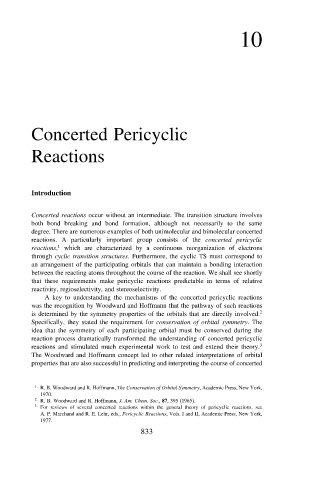Page 849 - Advanced Organic Chemistry Part A - Structure and Mechanisms, 5th ed (2007) - Carey _ Sundberg
P. 849
10
Concerted Pericyclic
Reactions
Introduction
Concerted reactions occur without an intermediate. The transition structure involves
both bond breaking and bond formation, although not necessarily to the same
degree. There are numerous examples of both unimolecular and bimolecular concerted
reactions. A particularly important group consists of the concerted pericyclic
1
reactions, which are characterized by a continuous reorganization of electrons
through cyclic transition structures. Furthermore, the cyclic TS must correspond to
an arrangement of the participating orbitals that can maintain a bonding interaction
between the reacting atoms throughout the course of the reaction. We shall see shortly
that these requirements make pericyclic reactions predictable in terms of relative
reactivity, regioselectivity, and stereoselectivity.
A key to understanding the mechanisms of the concerted pericyclic reactions
was the recognition by Woodward and Hoffmann that the pathway of such reactions
is determined by the symmetry properties of the orbitals that are directly involved. 2
Specifically, they stated the requirement for conservation of orbital symmetry. The
idea that the symmetry of each participating orbital must be conserved during the
reaction process dramatically transformed the understanding of concerted pericyclic
reactions and stimulated much experimental work to test and extend their theory. 3
The Woodward and Hoffmann concept led to other related interpretations of orbital
properties that are also successful in predicting and interpreting the course of concerted
1
R. B. Woodward and R. Hoffmann, The Conservation of Orbital Symmetry, Academic Press, New York,
1970.
2 R. B. Woodward and R. Hoffmann, J. Am. Chem. Soc., 87, 395 (1965).
3
For reviews of several concerted reactions within the general theory of pericyclic reactions, see
A. P. Marchand and R. E. Lehr, eds., Pericyclic Reactions, Vols. I and II, Academic Press, New York,
1977.
833

